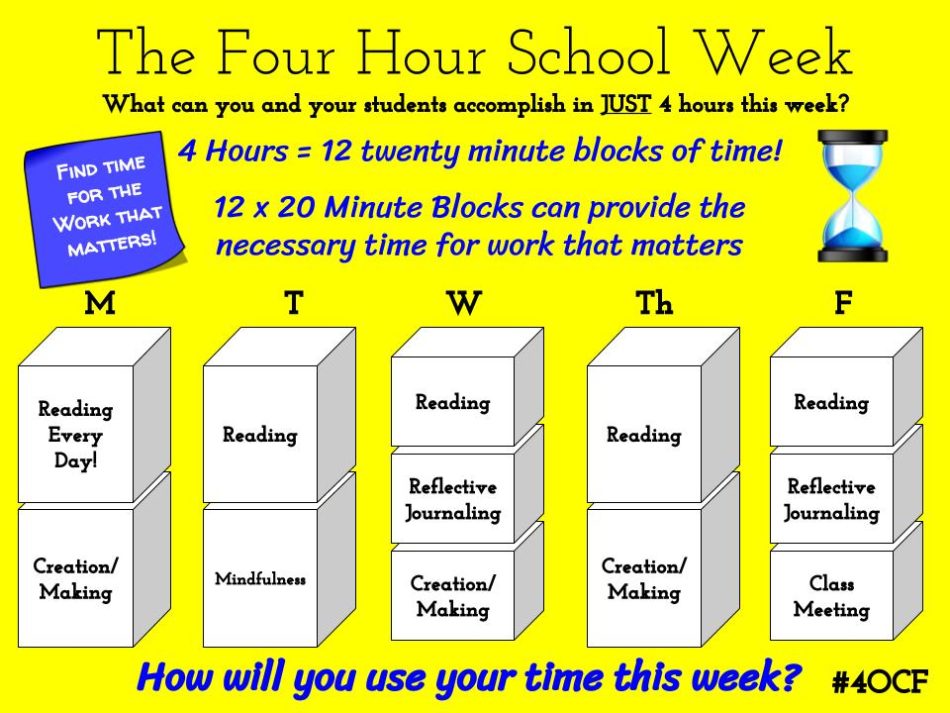I recently listened to the Unemployable podcast with Tim Ferriss, who is the author of several books including the Four Hour Work Week. While the book is several years old at this point, and has had it’s fair share of both positive and negative feedback, one of the main tenets of the book, and something Ferriss talked about on the podcast, is how we use our time. Time is one of the most valuable commodities that we have, although we often waste it.
William Penn said:
“Time is what we want most, but what we use worst.”
So, I began to question how we are utilizing time in school, and how we might better use time throughout our days and weeks. Although four hours does not seem like a lot of time, it can be utilized as valuable time to do work that matters.
While the visual suggests what four hours of meaningful work might look like, this is by no means a definitive schedule, and might look different based on what grades and subjects you teach, and the students that you work with on a daily basis. Ultimately, this schedule would work best in an elementary setting, where most students work with one teacher throughout the majority of their day.
Finding time as an educator can be a difficult task, but if we commit to making the time that we have more meaningful, we can help to better impact students.
As part of a Four-Hour School Week, the schedule might include:
5 x 20 minutes of Reading which will help students to become better readers and writers, and to explore important content and concepts. This time might be dedicated to fiction or nonfiction, and student choice can also help to make this time more relevant for students.
3 x 20 minutes of Creation/Making which will help students to synthesize and apply their learning, while allowing them to engage in their passions. This time might be utilized for students to work in a makerspace, or to write a screenplay, or to play with number concepts. Creation/Making would give students opportunities that they might not normally have.
2 x 20 minutes of Reflective Journaling which will provide time for students to reflect upon their learning. As students journal, they might ask questions about what they are reading about, or reflect upon their creation for the week. Three simple questions might guide this journaling: What went well? What did not go well? How can I improve?
1 x 20 minutes of Mindfulness which can help our students to be less stressed, and give them strategies that will make them more successful as students and as adults. Students can improve both mental and physical health, and the benefits will be evident in the classroom.
1 x 20 minutes of Classroom Meeting time can provide all students with the chance to collaborate, problem-solve, reflect, and celebrate their successes on a weekly basis. While this time may seem like an extra that simply can’t be squeezed into the day, the time can have a meaningful impact on the positive culture within your classroom.
Again, this schedule should not be seen as a definitive statement of all that our students should be doing, but rather a sample of how time can be better utilized to meet student needs. The point of what I am trying to explore is how we utilize our time.
Are we using the time we have with students for work that matters?
Even if this schedule is not possible for you, how can you better utilize time with students?
What can you accomplish with students in four hours this week?
Share in the comments section below or utilizing the hashtag #4OCF.
Special Thanks to Brian Clark and Tim Ferriss for their inspiration!
Rich (@RACzyz)
#4OCF Exceptional Educators Roaming the Edges to Expand Possibility



Comments are closed.